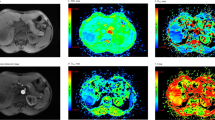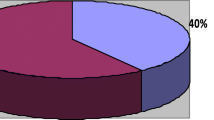Abstract
Objectives
To investigate the utility of diffusion-weighted imaging (DWI), apparent diffusion coefficient (ADC) and the correlation with hepatobiliary phase (delayed phase imaging, DPI) findings in the differentiation of cirrhotic hepatocellular nodules.
Methods
Forty-three patients with 53 pathology-proven nodules (29 hepatocellular carcinomas (HCCs), 13 high-grade (HGDNs) and 11 low-grade dysplastic nodules (LGDNs); mean size 2.17 cm, range 1–4 cm), who underwent liver MRI with DWI and DPI sequences, were retrospectively reviewed. Lesions were classified as hypointense, isointense, or hyperintense relative to the adjacent liver parenchyma. ADC of each nodule, of the surrounding parenchyma, and lesion-to-liver ratio were calculated.
Results
Hyperintensity versus iso/hypointensity on DWI, hypointensity versus iso/hyperintensity on DPI, and the mean lesion-to-liver ratio showed a statistically significant difference both between HCCs versus DNs and between “HCCs + HGDNs” versus LGDNs (p < 0.05); sensitivity, specificity, and accuracy for the diagnosis of “HCCs + HGDNs” were 96.8 %, 100 %, 97.4 % respectively when combining hyperintensity on DWI and hypointensity on DPI, and 90.9 %, 81.0 %, 83.6 % respectively when lesion-to-liver ratio was <0.95.
Conclusions
Hyperintensity on DWI, especially in association with hypointensity on DPI, and low lesion-to-liver ratios should raise the suspicion of HCC, or at least of HGDN, thus helping the characterization of atypically enhancing lesions.
Key points
• Usefulness of DWI and ADC is shown in differential diagnosis of cirrhotic nodules.
• Correlation of DWI with DPI improves differential diagnosis of cirrhotic nodules.
• Characterization of atypically enhancing lesions becomes more confident.





Similar content being viewed by others
Abbreviations
- DNs:
-
dysplastic nodules
- DPI:
-
delayed phase imaging
- FLLs:
-
focal liver lesions
- SI:
-
signal intensity
- FNB:
-
fine-needle biopsy
- CNB:
-
core-needle biopsy
- HGDNs:
-
high-grade dysplastic nodules
- LGDNs:
-
low-grade dysplastic nodules
- PPV:
-
positive predictive value
- NPV:
-
negative predictive value
- FN:
-
false negative
- FP:
-
false positive
References
Bruix J, Sherman M, American Association for the Study of Liver Diseases (2011) Management of hepatocellular carcinoma: an update. Hepatology 53:1020–1022
Jonas S, Bechstein WO, Steinmüller T et al (2001) Vascular invasion and histopathologic grading determine outcome after liver transplantation for hepatocellular carcinoma in cirrhosis. Hepatology 33:1080–1086
European Association for the Study of the Liver, European Organisation for Research and Treatment of Cancer (2012) EASL-EORTC clinical practice guidelines: management of hepatocellular carcinoma. J Hepatol 56:908–943
Jang HJ, Kim TK, Burns PN, Wilson SR (2007) Enhancement patterns of hepatocellular carcinoma at contrast-enhanced US: comparison with histologic differentiation. Radiology 244:898–906
Forner A, Vilana R, Ayuso C et al (2008) Diagnosis of hepatic nodules 20 mm or smaller in cirrhosis: Prospective validation of the noninvasive diagnostic criteria for hepatocellular carcinoma. Hepatology 47:97–104
Krinsky GA, Lee VS, Theise ND et al (2001) Hepatocellular carcinoma and dysplastic nodules in patients with cirrhosis: prospective diagnosis with MR imaging and explantation correlation. Radiology 219:445–454
Kim YK, Lee JM, Kim CS (2004) Gadobenate dimeglumine-enhanced liver MR imaging: value of dynamic and delayed imaging for the characterization and detection of focal liver lesions. Eur Radiol 14:5–13
Pirovano G, Vanzulli A, Marti-Bonmati L et al (2000) Evaluation of the accuracy of gadobenate dimeglumine-enhanced MR imaging in the detection and characterization of focal liver lesions. AJR Am J Roentgenol 175:1111–1120
Parikh T, Drew SJ, Lee VS et al (2008) Focal liver lesion detection and characterization with diffusion-weighted MR imaging: comparison with standard breath-hold T2-weighted imaging. Radiology 246:812–822
Le Moigne F, Durieux M, Bancel B et al (2012) Impact of diffusion-weighted MR imaging on the characterization of small hepatocellular carcinoma in the cirrhotic liver. Magn Reson Imaging 30:656–665
Piana G, Trinquart L, Meskine N, Barrau V, Beers BV, Vilgrain V (2011) New MR imaging criteria with a diffusion-weighted sequence for the diagnosis of hepatocellular carcinoma in chronic liver diseases. J Hepatol 55:126–132
Xu PJ, Yan FH, Wang JH, Lin J, Ji Y (2009) Added value of breathhold diffusion-weighted MRI in detection of small hepatocellular carcinoma lesions compared with dynamic contrast-enhanced MRI alone using receiver operating characteristic curve analysis. J Magn Reson Imaging 29:341–349
Vandecaveye V, De Keyzer F, Verslype C et al (2009) Diffusion-weighted MRI provides additional value to conventional dynamic contrast-enhanced MRI for detection of hepatocellular carcinoma. Eur Radiol 19:2456–2466
Park MS, Kim S, Patel J et al (2012) Hepatocellular carcinoma: detection with diffusion-weighted versus contrast-enhanced magnetic resonance imaging in pretransplant patients. Hepatology 56:140–148
Kim YK, Kim CS, Han YM, Lee YH (2011) Detection of liver malignancy with gadoxetic acid-enhanced MRI: is addition of diffusion-weighted MRI beneficial? Clin Radiol 66:489–496
Bruegel M, Holzapfel K, Gaa J et al (2008) Characterization of focal liver lesions by ADC measurements using a respiratory triggered diffusion-weighted single-shot echo-planar MR imaging technique. Eur Radiol 18:477–485
Sandrasegaran K, Tahir B, Patel A et al (2013) The usefulness of diffusion-weighted imaging in the characterization of liver lesions in patients with cirrhosis. Clin Radiol 68:708–715
Filipe JP, Curvo-Semedo L, Casalta-Lopes J, Marques MC, Caseiro-Alves F (2013) Diffusion-weighted imaging of the liver: usefulness of ADC values in the differential diagnosis of focal lesions and effect of ROI methods on ADC measurements. MAGMA 26:303–312
Lim KS (2014) Diffusion-weighted MRI of hepatocellular carcinoma in cirrhosis. Clin Radiol 69:1–10
Taouli B, Tolia AJ, Losada M et al (2007) Diffusion-weighted MRI for quantification of liver fibrosis: preliminary experience. AJR Am J Roentgenol 189:799–806
Guiu B, Cercueil JP (2011) Liver diffusion-weighted MR imaging: the tower of Babel? Eur Radiol 21:463–467
International Working Party (1995) Terminology of nodular hepatocellular lesions. Hepatology 22:983–993
International Consensus Group for Hepatocellular Neoplasia (2009) Pathologic diagnosis of early hepatocellular carcinoma: a report of the international consensus group for hepatocellular neoplasia. Hepatology 49:658–664
Rothman KJ (1990) No adjustments are needed for multiple comparisons. Epidemiology 1:43–46
Perneger TV (1998) What’s wrong with Bonferroni adjustments. BMJ 316:1236–1238
Xu PJ, Yan FH, Wang JH, Shan Y, Ji Y, Chen CZ (2010) Contribution of diffusion-weighted magnetic resonance imaging in the characterization of hepatocellular carcinomas and dysplastic nodules in cirrhotic liver. J Comput Assist Tomogr 34:506–512
Holzapfel K, Bruegel M, Eiber M et al (2010) Characterization of small (≤10 mm) focal liver lesions: value of respiratory-triggered echo-planar diffusion-weighted MR imaging. Eur J Radiol 76:89–95
Gourtsoyianni S, Papanikolaou N, Yarmenitis S, Maris T, Karantanas A, Gourtsoyiannis N (2008) Respiratory gated diffusion-weighted imaging of the liver: value of apparent diffusion coefficient measurements in the differentiation between most commonly encountered benign and malignant focal liver lesions. Eur Radiol 18:486–492
Kobayashi M, Ikeda K, Hosaka T et al (2006) Dysplastic nodules frequently develop into hepatocellular carcinoma in patients with chronic viral hepatitis and cirrhosis. Cancer 106:636–647
Borzio M, Fargion S, Borzio F et al (2003) Impact of large regenerative, low grade and high grade dysplastic nodules in hepatocellular carcinoma development. J Hepatol 39:208–214
Longchampt E, Patriarche C, Fabre M (2000) Accuracy of cytology vs. microbiopsy for the diagnosis of well-differentiated hepatocellular carcinoma and macroregenerative nodule. Definition of standardized criteria from a study of 100 cases. Acta Cytol 44:515–523
Sersté T, Barrau V, Ozenne V et al (2012) Accuracy and disagreement of computed tomography and magnetic resonance imaging for the diagnosis of small hepatocellular carcinoma and dysplastic nodules: role of biopsy. Hepatology 55:800–806
Gatto A, De Gaetano AM, Giuga M et al (2013) Differentiating hepatocellular carcinoma from dysplastic nodules at gadobenate dimeglumine-enhanced hepatobiliary-phase magnetic resonance imaging. Abdom Imaging 38:736–744
Lee MH, Kim SH, Park MJ, Park CK, Rhim H (2011) Gadoxetic acid–enhanced hepatobiliary phase MRI and high-b-value diffusion-weighted imaging to distinguish well-differentiated hepatocellular carcinomas from benign nodules in patients with chronic liver disease. AJR Am J Roentgenol 197:W868–W875
Di Martino M, Di Miscio R, De Filippis G et al (2013) Detection of small (≤2 cm) HCC in cirrhotic patients: added value of diffusion MR-imaging. Abdom Imaging 38:1254–1262
Acknowledgments
The scientific guarantor of this publication is Lorenzo Bonomo. The authors of this manuscript declare no relationships with any companies, whose products or services may be related to the subject matter of the article. The authors state that this work has not received any funding. One of the authors has significant statistical expertise. Institutional Review Board approval was obtained. Written informed consent was not required for this study because of its retrospective nature. Methodology: retrospective, observational, performed at one institution.
Author information
Authors and Affiliations
Corresponding author
Rights and permissions
About this article
Cite this article
Inchingolo, R., De Gaetano, A.M., Curione, D. et al. Role of diffusion-weighted imaging, apparent diffusion coefficient and correlation with hepatobiliary phase findings in the differentiation of hepatocellular carcinoma from dysplastic nodules in cirrhotic liver. Eur Radiol 25, 1087–1096 (2015). https://doi.org/10.1007/s00330-014-3500-7
Received:
Revised:
Accepted:
Published:
Issue Date:
DOI: https://doi.org/10.1007/s00330-014-3500-7




